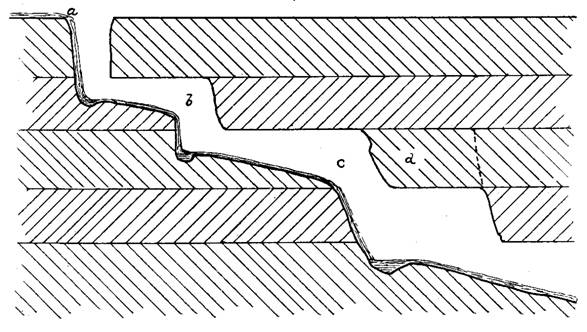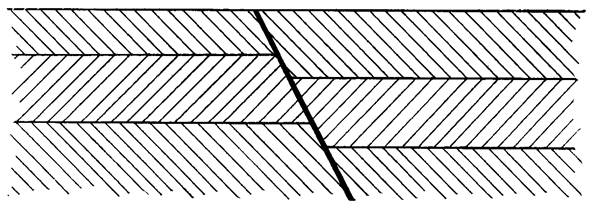Limestone Caverns And Pot-Holes And Their Mode Of Origin
By Arthur R. Dwerryhouse, D.Sc., F.G.S.
As the Club has made a speciality of Cave Exploration and has in the vicinity of its head-quarters so many magnificent examples of limestone caverns, it has been thought that some account of their mode of origin may not be out of place in the Journal.
Accordingly the Editor has asked me to express briefly, my views on the subject, and this I willingly do, although some of my ideas are yet in a crude and incomplete condition; because I hope that by these lines many of our working members may be induced to apply my theories to caves with which they are familiar as well as to others which they may visit in the future, and where necessary add to or amend them.
We can have no doubt that, in the first instance, caves in limestone rocks are due to the fact that water containing carbonic acid in solution is capable of uniting with the substance of the limestone (calcium carbonate) to form a soluble body. The natural result of the formation of this soluble compound is the transport of limestone substance from one place to another at a lower level.
The form which is taken by the cavity produced by this removal of matter depends upon the physical condition of the limestone, both as regards its texture and the nature of its jointing. Thus we may contrast the action of natural waters upon two limestones of widely different texture, as for example the Chalk of the Wolds, and the Carboniferous Limestone of the Yorkshire Dales.
The former possesses a highly porous texture, and consequently rain falling upon its surface is immediately absorbed and rapidly becomes saturated with calcium carbonate, with which it is thus brought into intimate contact. Here, then, the water becomes saturated after I passing through at most a few feet of strata, and consequently its solvent action is confined to the upper layers of the rock. The result is the general lowering of the land surface, but no caves are produced.
The Carboniferous Limestone on the other hand is usually a highly crystalline and quite impervious rock. Water which falls upon its surface rapidly flows off until it reaches some crack or fissure, down which it falls.
In flowing over the surface the water doubtless dissolves more or less of the limestone, as is evidenced by the flutings which are so characteristic of the surfaces of limestone “clints,” but it is certain that in most instances it enters the cracks and fissures in an unsaturated condition, and is consequently capable of eating its way through the mass of the rock by further solution.
It appears to me that the form of a cave will in the first place depend upon the nature and direction of the various cracks to which its inception is due.
The two principal classes of cracks in the Carboniferous Limestone are those which are approximately vertical and those which approach horizontality. The former include “joints” and “faults,” while the latter are the original planes of deposition technically known as bedding planes. Of course the bedding planes sometimes approach verticality in highly disturbed districts, but it is not my intention in the present note to discuss these complicated cases.
The joints appear to be the result of a contraction of the limestone, probably due to the drying and hardening of what was originally a calcareous mud. Whatever their origin these joints play a most important part in cave formation, and it is to their direction and relative persistency that the various types are due.
There are usually two sets of joints approximately at right angles to each other, and together with the bedding planes they divide the limestone into cuboidal masses. Usually one set of joints is more persistent than the other, and these we will call the “master joints.” The simplest type of cave is produced when the direction of the master joints corresponds to that of the dip of the bedding planes. In this case a long straight tunnel is produced, which may keep to the same bed of limestone throughout or may from time to time pass to a lower level by way of a secondary joint, subsequently resuming its original direction along a master joint. When the master joints do not coincide in direction with the dip of the beds or where there is no possible outlet in that direction the matter is more complicated, both “master” and “secondary” joints now come into play not only as regards changes of level in the roof of the cave, but also changes of direction. An underground stream may follow a master joint for some distance and then turn at right angles along a secondary, again fall into a master joint, and so on, producing a series of zig-zags.
The most common type is the long, narrow, tunnel-like cave, such as Clapham Cave, Stump Cross and Long Churn.
In all these cases it may be noticed that the most common form of cross section is wide at the top and narrow below.
It is necessary to remark at this stage that although simple solution of the limestone is responsible for the origin of a cave its final form is due to solution combined with the erosive action of boulders, pebbles and sand carried along by the stream.
At first the water percolates slowly down a narrow crack on a line of joint until it finds a plane of weakness, usually a bedding plane, along which it can flow. It continues its work of solution along this plane producing a cave with a cross section such as that in Fig. 1. While this is proceeding the joint down which the water percolates is gradually undergoing enlargement until eventually it becomes sufficiently wide to admit sand, pebbles, and even Ramblers.
With the introduction of sand and pebbles, a new phase in the history of the cavern is commenced. A channel is now worn by friction on the wide floor of the horizontal fissure, producing eventually the type seen in Fig. 2.
This channel winds from side to side, just as does an ordinary brook or rill on the surface of the ground, except in so far as it is confined by the sides of the cave and influenced by the direction of the joints.
Many of the most familiar phenomena of surface rivers are reproduced underground by this action; for example, the windings are often deserted, the stream taking a short cut and by the subsequent deepening of its bed leaving the old channel high and dry. Such deserted bends – or “ox-bows” as they are called by American geographers – are to be seen in Clapham Cave, Long Churn, and indeed in almost every cave of the tunnel type which I have visited.
So much for the plan and cross section of the caves; their longitudinal section still remains to be considered. Such a section of a typical tunnel-like cave is given in Fig. 3.
The water enters at a by way of a joint and reaches the bedding plane along which it finds its way to b, gradually wearing down its bed and enlarging the joint a. At b it descends another joint fissure and flows to c Where it encounters a third joint, which unlike a and b is continuous through two beds of limestone, and descends to a lower level. By the subsequent enlargement of these channels, cascades or waterfalls are produced at a, b and c, each having a pool at its foot, and by the falling-in of such a mass as that indicated at d a more or less lofty chamber may be produced.
It sometimes happens that a joint passes not through one or two beds of limestone but through many beds, perhaps to a depth of several hundreds of feet, in which case deep ” pots” are produced such as those at Gaping Ghyll, Alum Pot, Rift Pot, &c.
It seems probable that these continuous joints are in reality faults or dislocations of the strata (Fig. 4) and owe their continuity to this fact.
There still remains the type of cave consisting of extremely lofty chambers such as that at the bottom of Gaping Ghyll and these I am inclined to believe are due to falls of roof as indicated at d, Fig. 3, but of course on a larger scale.
I am aware that a few members of the Club consider this explanation inadequate, and I should therefore prefer to leave the fuller discussion of this type until I have had another opportunity of examining the Gaping Ghyll Caverns, when I hope further light will be thrown upon the matter.
It has been my object to put forward in this note some tentative working hypotheses rather than to make any definite pronouncement of my views, with the object of stimulating more detailed work than has yet been possible under the somewhat difficult conditions which attend speleological research, and I trust that members of the Club will utilize their unique opportunities for the investigation of these details with the same enthusiasm which they have shown in solving the larger problems which have been so well illustrated in previous numbers of the Journal.



